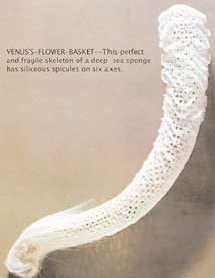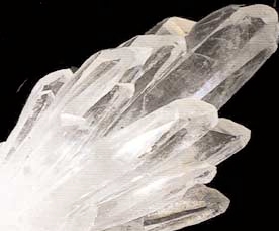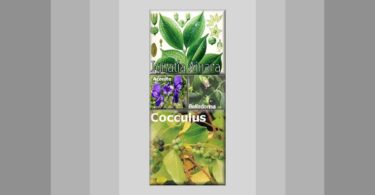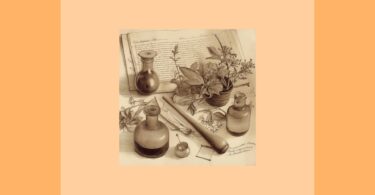Silicea stands close to Sulphur in the volcanic phase of planetary evolution, but as life evolved in the oceans it showed its relationship to Calcarea carbonica Both archetypes share a fear of life, which they perceive as hostile and threatening. The molluscs express this fear in the development of a protective shell fashioned of Calcarea carbonica The sponges use pure Silicea to produce their exquisitely designed skeletons. This artistry reaches the height of perfection in the skeleton of the deep-sea glass sponge, known as Venus’ Flower Basket. It is a fragile cathedral of Silicea spicules, executed in six axes with a delicacy, grace, and refinement of form, which perfectly expresses the spirit of this sublime substance.
In the carboniferous period, Silicea showed its close relationship with Lycopodium. Alongside the regal Lycopods, those mighty forbears of the humble club-moss, stood the almost as impressive, silica-rich Sphenopsids, the ancestors of the horsetails – Equisetum. As weather conditions changed and rainfall diminished, they too had to undergo a drastic reduction in size in order to survive, and also contributed to the vegetable material, which produced the extensive coal deposits, which millions of years later fired the Industrial Revolution. This falling off and loss of stature has ever since afflicted both archetypes with a sense of diffidence and inferiority. Both however possess minds which have boosted the technological and scientific explosion of the modern world.
The world of the mind is the world of the Silicea type – it is his haven – safe and secure. Silicea types become scientists, astro-physicists, cosmologists, astronomers, paleo-anthropologists, archaeologists, mathematicians, computer-analysts, information-technologists. However unlike Sulphur and Lycopodium, they usually possess a wonderful balance between right and left cerebral activity and, like Isaac Newton, one of the last of the mystic scientists, they are able to perceive the majesty of the creation, in all its scientific detail, and still retain a reverence for God and belief in the spiritual destiny of man.
This perfect and fragile skeleton of a deep-sea sponge has siliceous spicules on six axes
Photo from The Illustrated World of Science Encyclopedia: Volume 5
(Chicago 1971) courtesy of Creative World Publications Inc
Silicon is situated in the carbon group of the periodic table of elements, next to the element carbon. This transitional point is of great significance to man because it is from here that the first unicellular organism and subsequently all life came into being, and the majesty of our earthly landscape, which forms the stage and backdrop for life’s unfolding, took shape. Whereas carbon is the key element in the evolution of all organic life, silicon is the planetary architect and sculptor whose genius and artistry create mountain and valley, crag and ravine. With infinite virtuosity the giant molecules of these two elements bring into being either a wonderful diversity of life forms, or the magical splendour of the crystal world.
Silicea is a compound of the two most abundant elements of the earth’s crust – oxygen and silicon – and makes up 60 per cent of its mass, being the main component of more than 95 per cent of the earth’s rocks. The exceptions are the carbonate formations – limestone and dolomite. Many varieties of quartz are vibrantly coloured due to the presence of other elements as impurities: amethyst – purple violet; sapphire – indigo-blue; onyx – black to white; jasper – red; opal – iridescent, due to small inclusions of calcium carbonate.
The word crystal derives from krystallos, the Greek word for ice, which is also the Greek name for quartz. Crystal is now the generic term for all solid particles in which the atomic or molecular constituents are arranged according to strict, regularly repeated, geometrical design. Hence Silicea, quartz, or rock crystal, has become the very symbol of crystallisation and form, and truly the sphere of Silicea is a domain of myriad shapes and exquisite colours. Any substance that crystallises and attains form is shaped from within and closed off from without, and it is these two contending forces, a creative force and a formative force, which reside within Silicea – the crystal – the remedy – and the archetype. The crystal has an infinite capacity to grow by accretion, continually adding to itself, but whilst the creative force urges growth and expansion, it is rigidly constrained and conformed by a strict geometrical design imposed by the formative force, which always achieves the pyramid that finally crowns the crystal – the eternal symbol of spiritual evolution and attainment.
This inner contention between seemingly opposing forces – between extraversion and introversion, creativity and reserve, obstinacy and acquiescence, the desire to achieve and fear of failure, ambition and hesitant timidity, a brilliant mind and a delicate body – is fundamental to the Silicea personality. Silicea presents a paradox – the urge to develop and expand being ever opposed by the need to comply and conform.
Leonardo da Vinci captured this shaping from within and the struggle it involves when he wrote – “By the law of the Almighty the body is the work of the soul which fashions its outward appearance by hammering it from within, like a goldsmith embossing his material.”
The body is both the symbol and the tabernacle of the soul. The shape and form of this tabernacle often indicates the aptitudes, tendencies and aspirations animating it. This is particularly true of Silicea.
The first symbol of Silicea is the molten magma, which pours forth onto the earth’s crust from deep subterranean chambers under the violent impulse of volcanic activity. Here we see the close relationship that exists between Sulphur and Silicea. Sulphur is the externalising energy, ever working from within outwards, just as it does in its healing action; Silicea is the fluid material, which, as it solidifies, gives shape and substance to the surface of the earth. This powerful external layer or skeleton, largely a vast accumulation of quartz crystals, is in relationship to the planet as a whole, only a thin crust – the earth’s skin. Below this skin the liquid silicates flow and seethe, penetrating the surface through volcanoes, which open up like boils, sinuses and fistulae, building up excess material on the outside. Silicea has a particular affinity for the skin and its appendages – the hair and nails; the formative sheath of the bones – the periosteum; the inner matrix of the bones into which calcium and phosphorus are deposited; and it suits skin lesions which simulate volcanic activity. From these correspondences we realise the aptness of Silicea in the treatment of: unhealthy skin which festers from the least injury; boils, acne, fistulae; splinters; thickened scars; weak, brittle, or thickened and unsightly nails; thin hair which splits, breaks and falls; loss of bone density – osteoporosis; infections of bone – osteitis and osteomyelitis; overgrowth of bone – exostoses, osteophytes and osteoarthritis.
Silicea has become the symbol of crystallisation with its myriad shapes and exquisite colours
The second and most revealing symbol of Silicea is glass. Although man has been manufacturing glass ever since it was invented in Mesopotamia about 5000 years ago, nature has been forming glass through volcanic activity for millions of years. This volcanic glass, the most common form of which is obsidian, is created when hot lava rapidly cools after oozing onto the earth’s surface. The main constituent of glass is Silicea and the special qualities of this remarkable material are shared by the Silicea being.
To divine these qualities fully it is necessary to observe the skilled artistry of the glass blower and the behaviour of the material he is working with. The molten glass is fluid, clear, malleable, yielding and pliant, conforming to every whim of the artist, yet when it sets it is strong, rigid and inflexible, but also transparent, delicate, brittle and fragile. The slightest blow sharply delivered at a critical point, or a sound wave of critical frequency can shatter it, whilst it has the strength and resilience to resist tremendous forces and sustain a symphony of sound. Such is the paradoxical nature of Silicea.
The Silicea adult
In character they are clear and transparent – guileless, honest, sincere and open. Often initially timid, hesitant, indecisive, naïve and impressionable, they are easily influenced and persuaded by others, but as they develop and mature, constantly learning from experience, forming their own beliefs, opinions, morals and values, ever building their crystal structure, they are imbued with strength and resolve. Once established their convictions are steadfast, invulnerable to persuasion or seduction. On matters of principle they can be extremely obstinate and unyielding. This inner strength is often belied by a physically refined and delicate appearance, and an exquisite sensitivity of disposition, which is easily moved to compassion and tears, but also renders them susceptible to every sensory impression, jarring their nervous system, and leaving them debilitated. Great strength of will and intellect are often coupled to a limiting weakness of constitution.
Glass is surely the most versatile of materials; it can be as imposing and sophisticated as the giant telescope mirrors and lenses used for penetrating the secrets of the cosmos, or as small and simple as a child’s marble. The mind of Silicea is similarly versatile, able to encompass and master concepts of universal scope and be at ease with the finest detail, and give both the same attention. One of their charms is that even the great remain free from conceit and pretension. Within the mature may be found the innocence, enthusiasm and playfulness of a child, and within the child may be found the wisdom of a sage.
Glass restores our failing eyesight and projects our vision with clarity to the world about us – and also to the world within us, because as the first mirror after water it permits us to view the hidden aspects of our inner nature etched into our features by the workings of the soul. The lens of our eye is largely a Silicea organ. As such Silicea is our window to life, and also the window of our souls. Silicea bestows both sight and insight, giving its archetype not only an intuitive sense of the motives and traits of others, but also the blessing of self-awareness and selfknowledge. They are true unto themselves. They are capable of seeing the evil in good and the good in evil.
In our everyday lives, glass secludes, insulates and protects us whilst maintaining our visual union and communication with the world about us – it does not sever or isolate. The advanced Silicea is in this world, but not of it. They know that this life is but a stage for the schooling of the soul, and that behind it lies the reality from which we have come and to which we shall return. Whilst assisting, inspiring and caring for others, they are capable of dispassion and detachment. They can distance themselves without dissociating.
The lens of the telescope displays the macrocosm; the lens of the microscope and the technology of glass fibre optics reveal the world of the infinitely small – the microcosm. The same technology permits the human mind to project itself through sound and visual signals across the planet. It has extended our powers of communication and the dissemination of knowledge. In the silicon chip the mineral world vies with the organic world in memory and intelligence, and tiny quartz crystals provide us with the quintessential timekeeper, precise and accurate regardless of temperature or position. All of this relates to Silicea, and its archetype.
The Silicea mind is fascinated by the infinite and the infinitesimal, by the distant past and the remote future, by painstaking observation, exactitude and accuracy. It is a Silicea who can spend hours, days and months fine chiselling and brushing a fragment of fossilised bone out of its encasing rock with infinite patience and loving care. Fixity of purpose, and devotion to the finest detail is a characteristic of Silicea. The passion of Silicea is often a cerebral passion. They may compensate for lack of physical prowess and stamina by developing their mental abilities and knowledge, earning their laurels through intellectual feats. Many a “nerd” and “boffin” is a Silicea. Though reserved and lacking self-confidence they are determined and focused. They study, and they over-study, building an intellectual edifice which will be admired and give them confidence.
Glass also embodies colour, light, art and music. The glass prism reveals the hidden wonders of the spectrum; glass art is as versatile as the material it uses, producing works of great beauty, elegance and delicacy; a glass musician can make glass emit celestial music – like hearing angels sing. All of this is inherent in the archetype, for Silicea is artistic, imaginative and creative, or possesses a strong aesthetic awareness and appreciation. Silicea may be the artist or author with self-doubt, daunted by the empty canvas or page, or the creator who is never quite done, always adding a further detail, always embellishing or changing a word. A dose of Silicea in potency will unlock their confidence and their creativity, and permit them to put down their tools when the work is completed.
Nor may we forget “the crystal ball” which enhances psychic powers, the eye through which the fortuneteller or prophetess peers into the halls of other dimensions. Just as glass fibre optics extends our means of communication over vast distances on the earthly plane, so the sensitivity of Silicea extends beyond the merely physical, accessing the vibrations of unseen realms by means of love, empathetic perception, intuition, telepathy, clairvoyance, clairaudience, trance states, astral-projection and hypnosis. Quartz crystals possess healing power and since they have power to split light into its component colours, their healing influence can touch all levels of disease manifestation, all the chakras and hence all the systems and organs of the body. Healing in its various forms is often the vocation or natural gift of the Silicea archetype.
A third symbol of Silicea is sand. Sea sand is quartz in the almost pure state. Sand is grit, and grit is determination, perseverance and courage. When the Silicea energy in a constitution is low there will often be a lack of these grit qualities, physically and morally, and hence a lack of energy, resistance and confidence. It is a state of weakness, doubt and self-consciousness, and a fear of standing up for their rights, which persuades them to comply, yield and give up. They frequently suffer from dread of failure, despite great natural ability, and will avoid challenges rather than risk defeat. By homeopathic potentisation, medicinally inert sand is transformed into Silicea energy, which in susceptible subjects bestows fortitude and tenacity upon the vulnerable and the timid.
In others the Silicea energy is too high. Once committed to a task these individuals do not know when enough is enough, or when to stop. With immense strength and determination of will, often against all odds, and even when exhausted by their endeavours, they struggle on, even to the point of burnout.
The Silicea child
Sand can wear away rock, and sand children know this. Despite their shyness and timidity they possess a determination to get what they want.
The Silicea child can nag continuously. Once they have made up their minds they will persist until their demands are met, wearing down their parent’s resistance with pleas and beseeching. If denied, there is great anger with floods of tears, and then a stubborn sulkiness, which does not easily yield to parental supplication or reasoning. Whilst Calc carb is stubborn in its fears, Silicea is stubborn in its sulks and its tears.
Walk on the beach and feel the soft, yielding sand beneath your feet. It is comforting and soothing, but let a wind strike up, whipping those selfsame grains against your face, and feel their bite and their sting. Such may be the nature of the seemingly placid and forgiving Silicea. Able to withstand persistent provocation with admirable constraint, a trifle may arouse an uncharacteristic and even violent anger. Contradiction is the most frequent cause.
As it spiritually evolves the Silicea archetype, ever aspiring to perfection, striving always to achieve ist crowning pyramid, unites its conflicting polarities and finds a stability, serenity and capacity for unconditional love which is manifested in its final symbol, the rare heart-shaped twinning of the quartz crystal – an image of the heart and love of Silicea.









Thank you for a lovely and helpful portrait.
This is the most amazing and beautiful descriptionthat I have ever read regarding silicea thank for opening my mind and heart
Thank you!
For the the beauty, for sharing your deep insight and for writing so extensively.
It had been suggested to me that silica was my constitutional remedy, but so long ago, I had forgotten.
I was young and could not relate to the description I was presented.
Thanks to your utterly poetic and perceptive description, now, in my late fifties it sings to me!
It resonates on all levels – and helps me focus on my strengths and reaching for the silica, when self doubt sets in.
The synchronicity in that I’ve recently been reading and writing about sand, silica, glass, obsidian, corals, quartz and crystal just confirms it – I know who I am!
just wonderful insight ful article of Silica
Silicia,EA Maury has given pen picture child is timid fearful easily provokable MISTRUST in unknown say child will not go to lap of stranger will cry,there is poor development pallor waxy sagging skin distaste hot food chest weak thick yellow expectorate thirsty nails yellow occipital headache demineralised subject,constitution pale sickly narrow thorax thin limbs large head.
Neurasthenia hyper sensitive to low sounds is weak both physically and weak fearful nervous system prone to epileptic type fits.silicia and thuja are complementry thuja blood toxic if intolerance to serotherapy.
Maury says such personality CIRCULATION disturbances create multi problems other two remedies Pulsa Chamo also be compared they also have mind related circulation disturbance.treat chronic case when acute flareup is not there suggested potency 200c once fortnight.